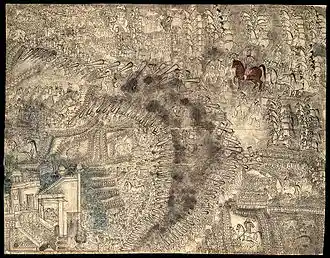The Battle that changed history
We left the story at the point when Chhatrapatis became the puppets and Peshwas became the de facto rulers. The Peshwas hadn't seen the face of defeat in decades. Would that fact remain the same after the battle that changed the history of India?

A painting depicting the Third Battle of Panipat; Image source: Wikipedia
Bajirao I established an empire that could be thought of as the epitome of Maratha power. His son, Balaji Bajirao too, followed in his footsteps by winning over numerous lands. He even struck a contract with the Mughals where the Marathas reserved the right to collect tax (Chauth and Sardeshmukhi) in regions that were previously under Mughal. In return, they promised to give the support of calvary in times of war. The Mughal ruler only became a name and Marathas had emerged as the true power figure.
In the 30-40 year reign of Bajirao I and his son, Balaji Bajirao, Marathas could not be defeated. Bajirao was a general who remained undefeated in 20 years of his military career and his son followed him. However, during Balaji Bajirao’s reign, the policy of raiding and looting were extremely prominent.
Maratha rule in many places remained to looting, collecting Chauth and no formal authority or administration was put in place. The high rate of taxes and the endless military campaign made a lot of enemies for Marathas. This is probably why in this upcoming battle, the Marathas were left alone without allies.
We start the story of this battle with Ahmad Shah Abdali, also known as Durrani. Abdali is someone who is considered the founder of Afghanistan. His career started as a mere soldier in the army of Nadir Shah. From there, he became the founder of his own empire and the borderline of his empire is very similar to the lines of modern-day Afghanistan making him the founder of the country.
He has invaded India eight times between 1748 and 1767. The fifth invasion in 1761 is what we remember as the third Battle of Panipat. Panipat is a place nearly 100 kilometres north of Delhi. It is this place that witnessed the most disastrous battle of the 18th century. In fact, before the World Wars, it was the most devasting battle in which so many soldiers had died in a single day.
The third Battle of Panipat was a very huge scale battle where there were no winners. A battle that didn't decide who would rule India, rather decided who would not.
Let’s have a look at the other contestants of the battle.
Abdali was supported by the ruler of Awadh, Shuja-ud-Daulah and the Rohillas. Together, they formed a huge army. The Maratha army was no less. You can see on the map that Marathas had a huge area under their control. An army of around 1 lakh cavalry marched against the Abdali forces.
Do you know that along with 1 lakh Maratha calvary there were 4 lakh civilians? These people were following the army in hope of protection. These were people who wished to visit places of pilgrimage and thought going with the army would provide them with a safe passage. The Marathas hadn't seen the face of defeat in generation at least.
Much to everyone’s surprise the combined forces of the opponent completely shattered the Maratha forces. Balaji Bajirao’s son and cousin who were leading the army lost their lives, sending Balaji Bajirao into great shock. More than 50,000 Maratha civilians were killed in a single day.
Maratha's forces were strong as well which is why Abdali too faced consequences. His win wasn’t a huge win since he too lost soldiers and a significant portion of the treasury. In fact, after winning this war, he gained control of the Punjab region of India however he couldn't sustain his rule there and left India alone. Marathas though recovered a great deal but could never regain the glory they once had after this war.
The most important significance of this battle was the power vacuum. The Marathas were the most formidable forces in north India however, this battle shattered them and even shattered the Afghan forces. With no one in the condition to rule, it gave a pathway for a third power to occupy this vacancy and that was the British forces. Even though the British weren't that strong at that time but the defeat of Marathas provided them with an opportunity on a silver platter.
Ultimately this battle decided not the ruler of India but instead who would not rule India as it benefitted those who didn't take part in this battle more. The people who didn’t get involved in the battle included the Sikhs, Jats, and EIC. The Sikhs made their own empire and the Jats became more powerful. EIC’s victories knew no bounds. You would be surprised to know the difference between the map of 1765 and 1823. In a matter of 68 years, the British managed to win over almost the entire India.

The orange area shows the huge Maratha expanse prior to the Third Battle of Panipat. The opponents were the Durrani Empire (in green) and the Awadh forces (in Maroon) Image source: Wikimedia Commons


